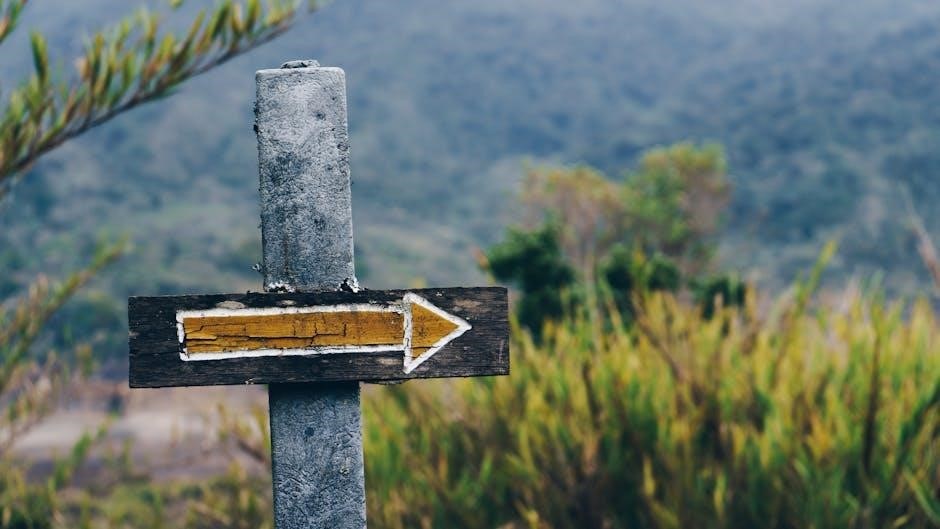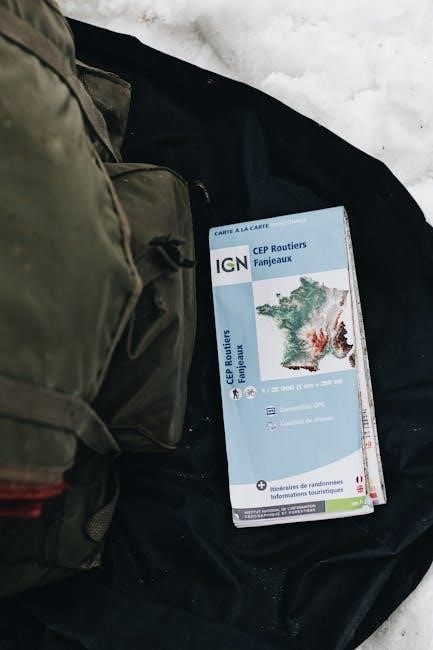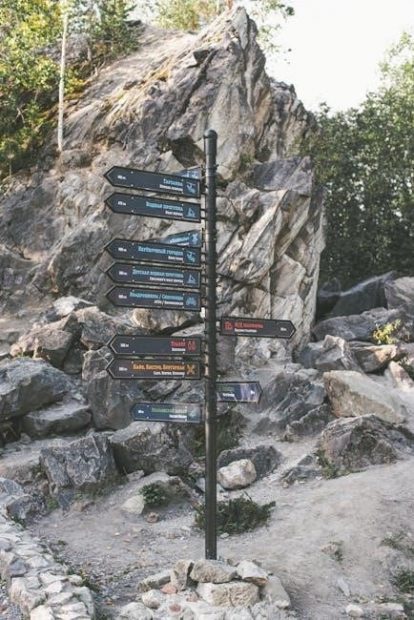The Trail Guide to the Body‚ 5th Edition‚ by Andrew Biel‚ is a renowned hands-on guide for locating muscles‚ bones‚ and soft tissue structures․ Published in 2014‚ this spiral-bound book is widely acclaimed for its detailed illustrations and practical approach‚ making it an essential resource for students‚ therapists‚ and healthcare professionals seeking to master musculoskeletal anatomy and palpation techniques․
Overview of the Book and Its Purpose
The Trail Guide to the Body‚ 5th Edition‚ by Andrew Biel‚ serves as a comprehensive‚ hands-on resource for identifying and understanding the human musculoskeletal system․ Its primary purpose is to provide clear‚ accessible information for students‚ therapists‚ and healthcare professionals to master the location and function of muscles‚ bones‚ and other soft tissue structures․ The book is structured to support both classroom learning and practical application‚ offering detailed illustrations and palpation techniques․ Its spiral-bound design makes it a durable and user-friendly tool for clinical settings‚ ensuring it remains an indispensable guide for anyone working with the human body․
Importance of Understanding Musculoskeletal Anatomy
Understanding musculoskeletal anatomy is essential for effective assessment and treatment in healthcare fields․ The Trail Guide to the Body‚ 5th Edition‚ emphasizes that accurate identification of muscles‚ bones‚ and soft tissues is crucial for diagnosing and addressing movement dysfunctions․ This knowledge enables professionals to apply targeted therapies‚ improving patient outcomes․ Students and practitioners alike benefit from the book’s clear illustrations and palpation techniques‚ fostering a deeper understanding of the body’s structure and function․ This foundational knowledge is vital for anyone working in physical therapy‚ massage‚ or sports medicine‚ ensuring safe and effective treatment practices․
Target Audience and Uses
The Trail Guide to the Body‚ 5th Edition‚ is designed for students and professionals in fields like massage therapy‚ physical therapy‚ and sports medicine․ It serves as a practical tool for learning musculoskeletal anatomy‚ with detailed illustrations and palpation techniques․ The book is ideal for both classroom study and clinical practice‚ offering a hands-on approach to understanding the body’s structure․ Its spiral-bound format and clear explanations make it accessible to beginners while providing depth for experienced practitioners․ The guide is also valuable for personal trainers and anyone seeking a comprehensive understanding of human anatomy for injury prevention or performance enhancement․
Key Features of the 5th Edition
The Trail Guide to the Body‚ 5th Edition‚ offers enhanced content and features to improve learning and practical application․ It includes updated illustrations‚ expanded palpation techniques‚ and detailed muscle descriptions․ The book provides a comprehensive approach to musculoskeletal anatomy‚ with a focus on hands-on identification and functional understanding․ New to this edition are improved organization‚ additional clinical applications‚ and digital resources for supplementary learning․ These features make it a valuable tool for students and professionals‚ ensuring a deeper grasp of human anatomy and its practical uses in various therapeutic and medical fields․

Muscles of the Body
The Trail Guide to the Body‚ 5th Edition‚ provides a comprehensive overview of muscle anatomy‚ function‚ and identification‚ emphasizing practical application for hands-on professionals․
Structure and Function of Muscles
Muscles are dynamic tissues designed for movement‚ comprising contractile units called sarcomeres․ The Trail Guide to the Body‚ 5th Edition‚ details muscle structure‚ including epimysium‚ perimysium‚ and endomysium․ Muscles function through contraction mechanisms‚ enabling movement‚ stabilization‚ and posture․ The book explains how muscles interact with bones‚ tendons‚ and ligaments‚ emphasizing their role in locomotion and bodily support․ It also explores muscle fiber types‚ such as skeletal‚ smooth‚ and cardiac‚ and their specialized functions․ Understanding muscle structure and function is crucial for professionals in manual therapy‚ as it informs effective palpation and treatment strategies․
Palpation Techniques for Muscle Identification
Palpation is a foundational skill for identifying muscles‚ requiring sensitivity and precision․ The Trail Guide to the Body‚ 5th Edition‚ provides detailed techniques for locating muscles through touch․ Flat palmar palpation is used for broad areas‚ while pisiform contact targets deeper tissues․ The book emphasizes the importance of patient relaxation and proper positioning․ Practitioners learn to distinguish muscle texture‚ tone‚ and movement․ Techniques are enhanced by understanding muscle origins‚ insertions‚ and actions․ The guide also offers practical tips for improving palpation accuracy‚ ensuring effective muscle identification for therapy and assessment․ These methods are essential for manual therapists and bodyworkers․

Common Muscles Covered in the Guide
The Trail Guide to the Body‚ 5th Edition‚ covers over 400 muscles‚ focusing on those most relevant to manual therapy and movement․ Major muscle groups include the neck flexors‚ shoulder rotators‚ abdominals‚ quadriceps‚ hamstrings‚ and glutes․ The guide also details smaller‚ often overlooked muscles like the interossei and rotatores․ Clear descriptions and illustrations help users understand each muscle’s origin‚ insertion‚ and action․ This comprehensive coverage makes it an invaluable resource for identifying and working with muscles in various clinical and therapeutic contexts․ The focus is on muscles essential for movement‚ stability‚ and posture‚ ensuring practical applications for professionals;
Muscle Groups and Their Roles
The Trail Guide to the Body‚ 5th Edition‚ organizes muscles into functional groups‚ such as flexors‚ extensors‚ and rotators‚ each serving distinct roles in movement and stability․ These groups work synergistically to enable actions like walking‚ lifting‚ and maintaining posture․ For example‚ the abdominals stabilize the core‚ while the quadriceps and hamstrings facilitate knee movement․ Understanding muscle groups helps professionals pinpoint imbalances or injuries‚ guiding effective treatment strategies․ The guide emphasizes how these groupings contribute to overall musculoskeletal function‚ making it easier to apply anatomical knowledge in clinical and therapeutic settings․ This approach enhances assessment and treatment accuracy for professionals working with the body․

Bones and Joints
Bones provide structural support‚ while joints enable movement․ The Trail Guide to the Body‚ 5th Edition‚ details bone types and joint classifications‚ aiding in understanding musculoskeletal mechanics․
Bone Structure and Landmarks
The Trail Guide to the Body‚ 5th Edition‚ provides a detailed exploration of bone structure‚ including the diaphysis‚ epiphysis‚ and metaphysis․ Landmarks such as condyles‚ trochanters‚ and spinous processes are highlighted to aid in palpation and identification․ The book emphasizes understanding bone morphology‚ from the spongy tissue of cancellous bone to the dense cortical bone․ These structural details are crucial for practitioners to locate anatomical reference points accurately․ The guide also includes high-quality illustrations and study aids to help learners master bone anatomy and its functional significance in movement and stability․
Major Bones of the Body
The Trail Guide to the Body‚ 5th Edition‚ identifies and details the major bones‚ focusing on their roles and locations․ The axial skeleton includes the skull‚ vertebral column‚ ribcage‚ and sternum‚ while the appendicular skeleton comprises the upper and lower limbs․ Key bones like the femur‚ humerus‚ pelvis‚ and sacrum are highlighted for their structural and functional importance․ The guide provides clear descriptions and illustrations to help learners identify and understand the significance of each bone in movement‚ support‚ and overall anatomy․ This section serves as a foundational reference for practitioners and students alike․
Types of Joints and Their Movements
The Trail Guide to the Body‚ 5th Edition‚ categorizes joints into three main types: synovial‚ cartilaginous‚ and fibrous․ Synovial joints‚ the most movable‚ include ball-and-socket‚ hinge‚ pivot‚ and gliding joints․ These allow a wide range of motions like flexion‚ extension‚ rotation‚ and circumduction․ Cartilaginous joints‚ such as those in the spine‚ provide limited movement‚ while fibrous joints‚ like skull sutures‚ are immovable․ The guide details each joint type‚ their anatomical structures‚ and functional movements‚ offering a clear understanding for therapists‚ students‚ and practitioners to apply in clinical and practical settings․
Bone and Joint Palpation Techniques
The Trail Guide to the Body‚ 5th Edition‚ provides detailed methods for palpating bones and joints‚ enabling precise anatomical identification․ Techniques include using light and deep pressure to locate bony landmarks‚ joint lines‚ and articular surfaces․ The guide emphasizes systematic palpation‚ starting with superficial structures before progressing to deeper tissues․ It also covers joint end-feel assessment and specific maneuvers for evaluating joint mobility․ Practitioners learn to distinguish normal and abnormal findings‚ enhancing diagnostic accuracy․ These techniques are essential for massage therapists‚ physical therapists‚ and bodyworkers to apply in clinical and therapeutic settings effectively․

Other Key Structures
The Trail Guide to the Body‚ 5th Edition‚ covers essential soft tissue structures‚ including tendons‚ ligaments‚ nerves‚ bursae‚ and fascia‚ crucial for movement and stability․
Tendons and Ligaments
Tendons and ligaments are critical connective tissues in the musculoskeletal system․ Tendons link muscles to bones‚ enabling movement‚ while ligaments stabilize joints by connecting bones․ Both are composed of collagen fibers‚ providing strength and elasticity․ The Trail Guide to the Body‚ 5th Edition‚ details their anatomy‚ function‚ and clinical significance․ It emphasizes palpation techniques to identify these structures‚ crucial for assessing injuries or imbalances․ Understanding tendons and ligaments is vital for practitioners to address common issues like strains or sprains effectively․ The guide also highlights their role in maintaining proper joint alignment and movement efficiency‚ essential for both therapy and prevention strategies in various clinical settings․
Nerves and Their Pathways
Nerves are specialized tissues that transmit electrical and chemical signals throughout the body‚ enabling communication between the central nervous system and peripheral structures․ The Trail Guide to the Body‚ 5th Edition‚ details the structure of nerves‚ including dendrites‚ axons‚ and myelin sheaths‚ which enhance signal transmission․ It also explores the pathways nerves follow‚ from spinal nerves to peripheral nerve networks․ Understanding nerve pathways is crucial for diagnosing and treating conditions like neuropathy or nerve compression․ The guide emphasizes the clinical relevance of nerve anatomy‚ helping practitioners identify and address nerve-related disorders effectively in various therapeutic settings․
Bursae and Fascia
Bursae are fluid-filled sacs that cushion joints‚ reducing friction between bones‚ tendons‚ and ligaments․ Fascia is a web-like connective tissue enveloping muscles‚ organs‚ and nerves‚ providing structural support and facilitating movement․ The Trail Guide to the Body‚ 5th Edition‚ details their roles in maintaining joint mobility and stability․ Bursae are commonly found near major joints like the shoulder and knee‚ while fascia forms a continuous network throughout the body․ Understanding these structures is vital for diagnosing conditions like bursitis or fascial restrictions․ The guide offers practical insights into their anatomy and function‚ aiding therapists in effective treatment and movement enhancement․
Other Soft Tissue Structures
Other soft tissue structures‚ such as retinacula‚ septa‚ and aponeuroses‚ play critical roles in movement and stability․ Retinacula hold tendons in place near joints‚ while septa divide muscle compartments‚ and aponeuroses serve as broad fascial sheaths․ These tissues work together to reduce friction and enhance mechanical efficiency․ The Trail Guide to the Body‚ 5th Edition‚ provides detailed illustrations and descriptions of these structures‚ helping practitioners identify and understand their functions․ This knowledge is essential for assessing injuries and developing effective treatment strategies‚ particularly in fields like physical therapy and massage therapy․ Understanding these tissues aids in restoring proper movement and reducing discomfort․

Palpation Techniques
The Trail Guide to the Body‚ 5th Edition‚ offers comprehensive palpation techniques with clear instructions and illustrations‚ essential for accurate soft tissue identification‚ injury assessment‚ and treatment planning․
Basic Palpation Skills
Mastering basic palpation skills is foundational for effective soft tissue assessment․ The Trail Guide to the Body‚ 5th Edition‚ emphasizes proper hand positioning‚ finger placement‚ and pressure adjustment․ Techniques include light‚ superficial touch for initial tissue response and deeper pressure for underlying structures․ The guide highlights the importance of using body weight rather than muscle strength for consistent pressure․ Students are taught to identify tissue texture‚ tone‚ and temperature variations‚ which are critical for detecting abnormalities․ Clear illustrations and step-by-step instructions help learners develop accuracy and confidence in their palpation practice‚ ensuring safe and effective application in clinical and therapeutic settings․
Advanced Palpation Methods
Advanced palpation methods in the Trail Guide to the Body‚ 5th Edition‚ build on foundational skills to enhance precision and diagnostic accuracy․ Techniques include layered palpation‚ where practitioners systematically examine superficial to deep tissues‚ and specific methods like cross-fiber palpation for identifying trigger points․ The guide also introduces dynamic palpation‚ where movement is incorporated to assess tissue response․ Advanced practitioners learn to integrate palpation with other assessment tools‚ such as range-of-motion testing‚ to refine their clinical decision-making․ Detailed illustrations and expert tips help refine these complex skills‚ enabling professionals to address intricate soft tissue challenges effectively in therapeutic and clinical settings․
Common Challenges in Palpation
Practitioners often face challenges in palpation‚ such as distinguishing between anatomically close structures or identifying tissues through varying depths of soft tissue․ The Trail Guide to the Body‚ 5th Edition‚ addresses these difficulties by emphasizing precise techniques and anatomical awareness․ Challenges also arise from individual variations in muscle tension‚ body composition‚ and pain sensitivity․ Developing a keen sense of touch and understanding tissue responses are crucial for overcoming these obstacles․ The guide provides practical strategies to refine palpation skills‚ ensuring accurate assessments even in complex cases․ Mastering these techniques enhances clinical outcomes and therapeutic effectiveness for professionals in bodywork and healthcare fields․
Improving Palpation Accuracy
Improving palpation accuracy requires a blend of anatomical knowledge and practical expertise․ The Trail Guide to the Body‚ 5th Edition‚ highlights the importance of understanding muscle origins‚ insertions‚ and surrounding structures to enhance precision․ Employing systematic techniques‚ such as beginning with broad strokes to identify landmarks before narrowing in on specific areas‚ enhances accuracy․ Incorporating both visual and tactile cues aids in precise tissue identification․ Regular practice and expert feedback are crucial for refining skills‚ leading to more effective and accurate assessments in both clinical and therapeutic environments effectively․

Clinical Applications
The Trail Guide to the Body‚ 5th Edition‚ is instrumental in clinical applications‚ enhancing assessment techniques‚ treatment strategies‚ and diagnostic approaches for professionals across physical therapy‚ massage‚ and sports medicine․
Assessment Techniques
The Trail Guide to the Body‚ 5th Edition‚ provides comprehensive assessment techniques essential for evaluating musculoskeletal function․ It details methods for observing posture‚ measuring range of motion‚ and testing muscle strength․ Professionals learn to identify imbalances and dysfunction through palpation‚ joint mobility assessments‚ and special tests․ The guide emphasizes accurate documentation and interpretation of findings to inform treatment plans․ Enhanced illustrations and updated protocols ensure precise evaluation of soft tissue‚ bones‚ and joints․ These techniques are invaluable for physical therapists‚ massage therapists‚ and sports medicine practitioners aiming to deliver evidence-based care and improve patient outcomes effectively․
Treatment Strategies
The Trail Guide to the Body‚ 5th Edition‚ offers evidence-based treatment strategies to address musculoskeletal dysfunction․ It provides detailed approaches for soft tissue manipulation‚ joint mobilization‚ and corrective exercises․ Techniques are tailored to specific conditions‚ such as pain relief‚ scar tissue reduction‚ and improved mobility․ The guide emphasizes personalized treatment plans‚ integrating palpation findings with therapeutic interventions․ Enhanced with updated protocols‚ it serves as a practical resource for clinicians to restore function and promote healing; These strategies are adaptable across various modalities‚ ensuring effective and lasting outcomes for patients in massage therapy‚ physical therapy‚ and sports medicine settings․
Diagnostic Techniques
The Trail Guide to the Body‚ 5th Edition‚ provides comprehensive diagnostic techniques to accurately assess musculoskeletal conditions․ It includes detailed palpation methods to identify pain points‚ muscle imbalances‚ and joint dysfunction․ Visual assessments and range-of-motion tests are emphasized to evaluate movement patterns and limitations․ The guide also covers the use of manual tests to detect soft tissue restrictions and neurological responses․ These techniques enable practitioners to pinpoint underlying causes of discomfort and dysfunction‚ ensuring precise and effective clinical decision-making․ The book’s clear instructions and illustrations make it an invaluable resource for both students and experienced professionals in bodywork and movement therapies․
Soft Tissue Manipulation
The Trail Guide to the Body‚ 5th Edition‚ offers detailed insights into soft tissue manipulation techniques‚ essential for effective bodywork․ It covers methods like massage‚ myofascial release‚ and trigger point therapy‚ providing clear instructions for applying these techniques․ The guide emphasizes proper hand placement‚ pressure‚ and strokes to address muscle tension‚ scar tissue‚ and fascial restrictions․ Illustrated with photographs and diagrams‚ it helps practitioners master techniques to improve circulation‚ reduce muscle spasms‚ and restore flexibility․ These methods are particularly valuable for massage therapists‚ physical therapists‚ and other professionals aiming to enhance client outcomes through targeted soft tissue interventions․

About the Book
The Trail Guide to the Body‚ 5th Edition‚ is a renowned textbook authored by Andrew Biel‚ offering a comprehensive understanding of musculoskeletal anatomy․ Widely used by professionals and students‚ it has become a trusted resource for its clear‚ detailed illustrations and practical applications in fields like massage therapy and physical therapy․ This edition includes updated content‚ enhanced visuals‚ and improved organization‚ solidifying its reputation as an essential tool for mastering human anatomy and bodywork techniques․
History of the Trail Guide to the Body
First published in 1997‚ the Trail Guide to the Body has become a cornerstone for anatomy education․ Created by Andrew Biel‚ the book was designed to bridge the gap between theoretical anatomy and practical application․ Its unique approach‚ combining detailed illustrations with palpation techniques‚ quickly gained popularity among bodyworkers‚ therapists‚ and students․ Over the years‚ the guide has evolved through five editions‚ each enhancing clarity and depth․ Its enduring success lies in its ability to make complex anatomy accessible‚ fostering a deeper understanding of the human body for professionals and learners worldwide․
Author Background and Expertise
Andrew Biel‚ the renowned author of the Trail Guide to the Body‚ brings extensive expertise in anatomy and bodywork․ A licensed massage therapist with decades of experience‚ Biel has taught anatomy to thousands of students worldwide․ His unique ability to simplify complex anatomical concepts has made the guide indispensable for professionals and learners alike․ Biel’s hands-on experience in massage therapy and education ensures the book’s practical relevance‚ while his clear‚ engaging writing style has solidified its reputation as a go-to resource for understanding human anatomy․
Edition Updates and Improvements
The 5th edition of the Trail Guide to the Body introduces significant updates to enhance learning and practical application․ New full-color illustrations provide clearer anatomical details‚ while surface anatomy images aid in identifying structures through palpation․ Expanded sections on palpation techniques and functional anatomy offer deeper insights into muscle and joint mechanics․ Clinical applications have been enriched with case studies and examples‚ making the guide more relevant to professionals․ The updated text incorporates feedback from educators and practitioners‚ ensuring it remains a user-friendly and indispensable resource for students and experts in bodywork and movement therapies․
Reception and Reviews
The 5th edition of the Trail Guide to the Body has received widespread acclaim for its clarity‚ comprehensiveness‚ and practicality․ Professionals and students alike praise its updated visuals and enhanced content‚ which make complex anatomy accessible․ Many reviewers highlight its value as both a learning tool and a clinical reference; The addition of full-color illustrations and real-world examples has been particularly well-received․ Educators often recommend it as a foundational text‚ and practitioners appreciate its focus on palpation and functional anatomy․ With its user-friendly design‚ it continues to be a go-to resource for anyone studying or working in bodywork and movement therapies․

Learning Resources
- The textbook provides in-depth musculoskeletal anatomy insights․
- Flashcards aid memorization of key structures and terms․
- Online supplements include interactive tools and videos․
- Study tips and guides enhance learning efficiency․
The Textbook
The textbook is the core resource for mastering musculoskeletal anatomy․ It provides detailed‚ full-color illustrations and clear descriptions of muscles‚ bones‚ and other structures․ Organized by body region‚ it simplifies learning and reference․ The 5th edition includes updated content‚ such as new illustrations and expanded information on functional anatomy․ Designed for students and professionals‚ it combines scientific accuracy with practical insights‚ making it an essential tool for hands-on therapies like massage and physical therapy․ Its clear‚ accessible format ensures that complex anatomical concepts are easy to understand and apply in real-world settings․
Flashcards and Study Aids
The Trail Guide to the Body 5th Edition is accompanied by flashcards and study aids to enhance learning․ The flashcards cover key anatomical structures‚ including muscles‚ bones‚ and ligaments‚ with clear images and concise descriptions․ They are color-coded by body region for easy organization․ Additional study aids‚ such as online interactive exercises and a companion handbook‚ provide further opportunities for review and practice․ These tools are designed to help students and professionals master musculoskeletal anatomy efficiently․ They are ideal for self-testing‚ quick reference‚ and reinforcing concepts learned in the textbook‚ making them invaluable for both classroom and clinical settings․
Online Supplements
The Trail Guide to the Body 5th Edition offers comprehensive online supplements to support learning․ These include interactive 3D models‚ video tutorials‚ and quizzes to reinforce anatomical knowledge․ Students and professionals can access digital versions of the textbook‚ along with downloadable resources like lecture slides and anatomical images․ The online platform also provides case studies and practical exercises for real-world application․ These supplements are designed to enhance engagement and retention‚ making complex concepts more accessible․ They are accessible via the book’s official website‚ ensuring users have seamless access to additional study materials anytime‚ anywhere․
Study Tips for Mastery
To master the Trail Guide to the Body 5th Edition‚ create a structured study schedule focusing on one anatomical region at a time․ Use the textbook’s detailed illustrations to visualize muscle and bone relationships․ Engage in active learning by labeling blank diagrams and testing yourself regularly․ Incorporate hands-on practice‚ such as palpation exercises‚ to reinforce theoretical knowledge․ Review complex concepts like joint movements and nerve pathways by teaching them to others․ Highlight and annotate key terms and sections for quick reference․ Consistency and repetition are key to building a strong foundation in musculoskeletal anatomy;

Practical Applications
The Trail Guide to the Body 5th Edition is a valuable resource for professionals in massage therapy‚ physical therapy‚ sports medicine‚ and personal training․ It aids in accurate assessment‚ effective treatment planning‚ and client education‚ enhancing overall client outcomes and professional development․
Massage Therapy
The Trail Guide to the Body 5th Edition is an indispensable tool for massage therapists‚ providing detailed insights into musculoskeletal anatomy․ It aids in identifying muscles‚ tendons‚ and ligaments through palpation‚ enabling precise and effective therapeutic techniques․ The guide enhances understanding of soft tissue structures‚ allowing therapists to design personalized treatment plans․ Its clear illustrations and descriptions help in locating trigger points and areas of tension‚ improving massage outcomes; By bridging anatomy and practice‚ the book supports therapists in delivering targeted‚ results-driven sessions‚ ultimately benefiting both practitioners and clients in achieving optimal wellness and pain relief․
Physical Therapy
The Trail Guide to the Body 5th Edition is a vital resource for physical therapists‚ offering comprehensive insights into musculoskeletal anatomy․ It aids in assessing movement patterns‚ identifying limitations‚ and developing targeted treatment plans․ The guide’s detailed descriptions of muscles‚ bones‚ and joints enhance understanding of functional anatomy‚ crucial for addressing mobility issues․ Its palpation techniques help therapists accurately locate areas of dysfunction‚ enabling effective manual therapy interventions․ By linking anatomical knowledge with clinical practice‚ the book supports physical therapists in designing personalized rehabilitation strategies‚ improving patient outcomes and restoring optimal movement and function․
Sports Medicine
The Trail Guide to the Body 5th Edition is an essential tool for sports medicine professionals‚ providing in-depth insights into musculoskeletal anatomy and its role in athletic performance․ It helps practitioners identify muscle imbalances‚ assess injury risks‚ and design tailored rehabilitation programs․ The guide’s detailed coverage of muscle groups‚ joint mechanics‚ and soft tissue structures enables precise diagnosis and treatment of common sports injuries․ By enhancing understanding of anatomical function‚ it supports the development of effective training and recovery strategies‚ ultimately improving athlete performance and reducing injury recurrence․ This resource is invaluable for optimizing care in sports medicine settings․
Personal Training
The Trail Guide to the Body 5th Edition is an invaluable resource for personal trainers‚ offering comprehensive insights into musculoskeletal anatomy․ It enables trainers to design targeted exercise programs by understanding muscle structure and function․ The guide’s detailed descriptions of each muscle group allow for precise workout planning‚ helping clients achieve specific fitness goals․ Additionally‚ the book’s emphasis on palpation techniques aids trainers in identifying muscle imbalances and potential injury risks‚ enabling them to tailor exercises for individual needs․ This resource enhances a trainer’s ability to deliver effective‚ personalized fitness plans‚ contributing to better client outcomes and satisfaction․
